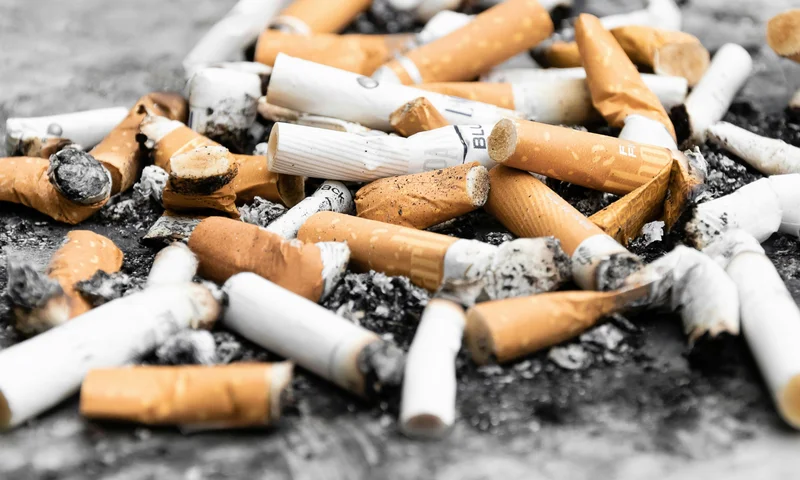Cigarettes and RYO: All about roll-your-own cigarettes
Cigarettes are one of the most widely used tobacco products in the world, but in recent years RYO (Roll Your Own) cigarettes have become increasingly popular. In this article you will learn everything you need to know about conventional cigarettes and the differences to RYO.
What are conventional and RYO cigarettes made of?
The dried and cured leaves of the tobacco plant are used to make cigarettes. Nicotine is the most addictive substance contained in cigarettes. Similar to heroin and cocaine, nicotine alters brain function and creates a craving for more nicotine.
According to studies, cigarettes contain a variety of harmful chemicals. Some are contained directly in the tobacco leaf, others are produced when the cigarette burns and some have been added by the cigarette manufacturers. Tobacco smoke contains more than 7,000 chemicals, almost 70 of which are carcinogenic.

Differences between conventional cigarettes and RYO (roll your own)
Cigarettes and RYO (Roll Your Own) differ primarily in the way they are consumed. While conventional cigarettes are industrially prefabricated and are bought in packs, RYO are self-rolled cigarettes where the smoker rolls the tobacco manually in paper.
Production and consumption:
- Conventional cigarettes: These cigarettes are industrially manufactured and come in standardized sizes and tobacco quantities. They are ready for immediate use and are sold in kiosks, supermarkets and tobacco stores.
- RYO cigarettes: For RYO, the consumer uses loose tobacco and special cigarette paper to roll the cigarettes themselves. Some smokers prefer RYO because they can determine the amount of tobacco themselves and enjoy rolling their own cigarettes as a ritualized process.
Tobacco quantity and nicotine content:
- Conventional cigarettes: Each cigarette contains a fixed amount of tobacco, which ensures an even nicotine content.
- RYO cigarettes: As smokers can determine the amount of tobacco themselves, the nicotine content varies according to preference. This can lead to a higher intake of nicotine, as roll-your-own cigarettes often contain more tobacco than industrially manufactured cigarettes.
Health aspects:
Both conventional cigarettes and RYO contain harmful chemicals that can cause serious health risks such as lung cancer, cardiovascular disease and respiratory problems. There is no health benefit to rolling your own cigarettes - the levels of harmful substances remain similar for both options.
Harmful substances include:
- Carbon monoxide - this is found in car exhaust fumes, among other things.
- Lead, mercury, chromium and cadmium - toxic metals.
- Hydrogen cyanide - highly flammable and very toxic substance, also for aquatic organisms.
- Ammonia - is found in cleaning agents and is added to cigarettes to increase the nicotine kick.
- Polonium 210 - a radioactive substance.
Some of the toxins in cigarettes affect the mouth, throat and lungs, while others enter the entire body via the bloodstream. The longer a person smokes and the more often they smoke, the greater their risk of developing diseases such as lung cancer.
Health risks of cigarettes and RYO
Although many believe that roll-your-own cigarettes are less harmful, studies indicate that both cigarettes and RYO pose significant health risks. Both contain nicotine and tar, which can lead to lung cancer and other serious illnesses.
Why are roll-your-own cigarettes becoming increasingly popular?
Cigarette filters:
The cigarette filter is a constant target of product innovation by the tobacco industry. Most of the cigarettes or RYOs consumed worldwide have filters. After smoking, cigarette butts are often thrown in the trash or into the environment. Cigarette butts generally contain several toxic substances that are trapped in the cigarette filter. Filters are made of non-biodegradable materials such as cellulose acetate (a type of plastic) and remain in the environment for a long time. The cigarette butts themselves contain thousands of hazardous chemicals such as arsenic, benzene, hydrogen cyanide, PAHs (a very carcinogenic chemical), pyridine, heavy metals and so on.
Some studies have also stated that each cigarette butt can pollute up to 1000 liters of water. Other reports, such as by Kadir & Sarani (2015), indicate that some toxic effects can occur from one cigarette butt even at concentrations of one cigarette butt per 4,000 liters. Considering an estimated 1.2 million tons of cigarette butt litter per year, with these numbers expected to increase by more than 50% by 2025, cigarette butts have a devastating impact on our environment that remains largely unseen.

FAQ: Cigarettes and RYO in Switzerland
What is the difference between cigarettes and RYO?
Cigarettes are industrially manufactured tobacco products, while RYO (Roll Your Own) means that the consumer uses tobacco and cigarette paper to roll the cigarettes themselves.
Are RYO cigarettes less harmful than conventional cigarettes?
No, RYO cigarettes are no less harmful. They contain similar amounts of harmful substances as industrially manufactured cigarettes and pose the same health risks.
Why are more and more people turning to RYO cigarettes?
Many people opt for RYO cigarettes because they are often cheaper and allow consumers to determine the amount of tobacco themselves. However, this has no health benefits.
Are there differences in nicotine content between cigarettes and RYO?
The nicotine content depends on the amount of tobacco and the type of tobacco used for RYO. As a rule, both types of cigarettes contain similar amounts of nicotine.
What are the health risks associated with cigarettes and RYO?
Both cigarettes and RYO carry a high risk of diseases such as lung cancer, cardiovascular disease and chronic respiratory diseases. There is no safe way to consume tobacco.
How popular are RYO cigarettes in Switzerland?
RYO cigarettes are becoming increasingly popular in Switzerland, especially due to the lower costs and the possibility of producing individual blends. Nevertheless, the health risks are no less serious.
Sources
https://www.cdc.gov/tobacco/data_statistics/fact_sheets/index.htm
Hull, Philip (2014): Tobacco. HEALTH EFFECTS OF SMOKING. Ed. by Australian Government, Department of Health. Australian Government, Department of Health. Available online at https://positivechoices.org.au/documents/wCNbe7MOqJ/health-effects-of-tobacco-detailed-resource-for-parentsteacher
Unisanté (2014): Composition d'une cigarette. Ed. by Unisanté. Available online at https://tabagisme.unisante.ch/composition-dune-cigarette/.
The FDA Center for Tobacco Products (CTP) (ed.) (2016): How a Cigarette Is Engineered. The design and content of cigarettes continue to make them attractive, addictive, and deadly. Every day, more than 1,300 people in the United States die because of cigarette use. FDA. Available online at https://www.fda.gov/media/101198/download
https://www.bafu.admin.ch/bafu/de/home/themen/chemikalien/schadstoffglossar/blausaeure.html
AT Switzerland, October 2024